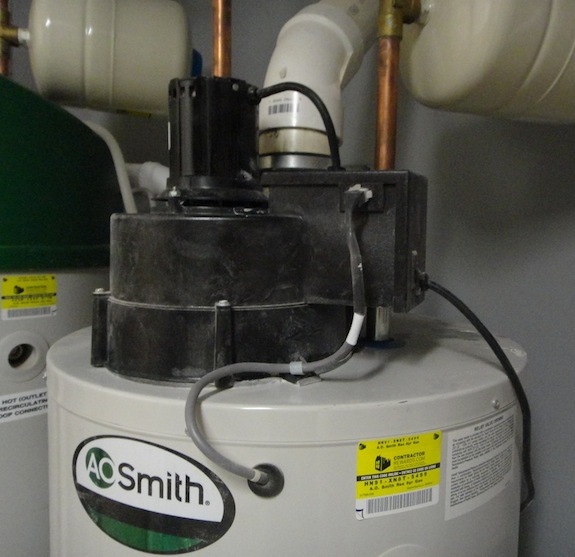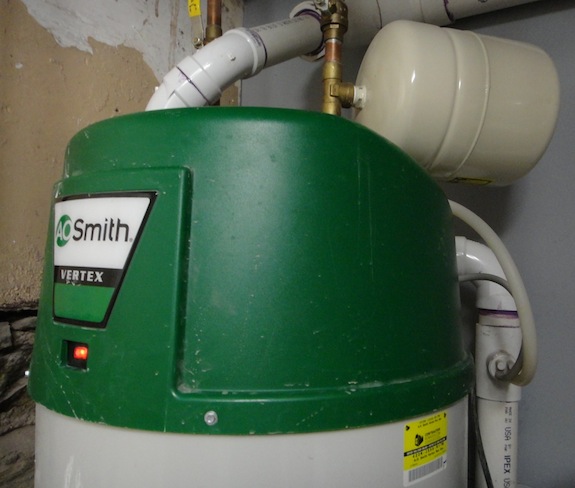Our hot water went out earlier this week. The cause? The boiler room was dirty. Seriously…
Old style water heaters just sat there. Their exhaust was hot, so it rose up the chimney without any effort. New water heaters aren’t anything like that. Hot air going up the chimney isn’t efficient – the heat should be going into the water, not the atmosphere. So they use fans to push the exhaust up the chimney. If you see fan motor sitting on top of your water heater you have one of the new, more efficient, water heaters…

Sometimes the fan is concealed a bit behind a plastic cover…

Because the exhaust gases are more condensed and not as hot, instead of using a tin chimney, you’re supposed to use PVC or CPVC or stainless. In fact you’re not allowed to use tin for the chimney – I think the gasses can corrode tin.
Anyway, the air the fans push up the chimney has to come from somewhere. There are two types of modern water heaters – Power Vent and Direct Power Vent. The term “Power Vent” means, they have a fan that pushes the exhaust up the chimney. Direct Power Vent means the air intake is piped from outside – air inside the boiler room is not used.
I wanted Direct Power Vent, but we were venting through the roof and the total length of piping for venting was a problem. You have to count the air intake into the total length of ducting allowed. In our case, since we have a 5 story townhouse, the intake pipe would have put us over the allowed ducting or dangerously close to being over.
Because the air on a Direct Vent water heater comes from the boiler room, not outside as the repair guy put it – “you’ve got a big vacuum cleaner” sitting in your boiler room. It sucks in air at the bottom, spirals it around the tank and pushes it out the top. So any loose dirt that’s sitting on your floor will get sucked into the water tank. If it’s not light enough to make it to the top of your chimney it will wind up falling back down into the fan when the fan turns off. Eventually it builds up and clogs the sensors that are there to make sure everything is working properly.
When the repair guy took off the chimney and started the fan a huge cloud of dust and dirt went into the air. Not good – and the cause of our problems. Luckily no parts had gotten fried, so as soon as he had cleaned things up everything was working again.
So in hindsight, if you can, I’d recommend a Direct Power Vent instead of a Power Vent. Your outside air is likely to be cleaner than the air in your boiler room. But whichever you have, be careful about the cleanliness of the air going being sucked in. With a Power Vent keep your boiler room clean. During construction that can be hard – so just turn the water heater off until the boiler room can be clean. Even with a Direct Power Vent you should worry if there’s dust in the air where the air intake is – for example, if they’re doing construction next door, etc.
One other thing the repair guy said was that PVC can be a problem for the vent stacks. Apparently the temperature can get high enough to crack the PVC. CPVC or stainless is better. We’ll keep the water temperature down to try to avoid that problem. If you do put in PVC, keep a close eye on it for problems.

Why wouldn’t there be an air filter between the intake and the fan? Seems like a logical and fairly cheap solution.
I asked that very question… “Because it would get clogged really quickly” was the answer. It does seem logical to have some sort of filter – I mean it’s rather critical.